I don’t even drink beer, but I participated in a beer making session — well, a truncated version — while on a return visit to Peru earlier in 2025. The beer was, in fact, the country’s famed chicha de jora, or corn beer.
The drink itself is nutritious, my group’s guide averred, because of the minerals in the corn and minerals picked up by grinding the grain on volcanic rock. He also said the new brew may have a 3% alcoholic content, but the alcohol level could be a lot higher with more fermentation.
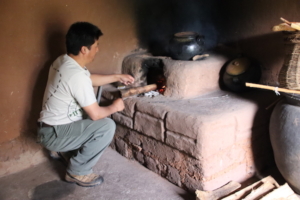
Our guide stoking the fire before adding ground corn and flour to boiling water in the early phase of converting corn into the alcoholic drink, chicha de jora.
I wanted to see this demonstration and participate as well because the story of the beer is fascinating and it is a traditional part of Peru’s culture. Besides, fortunately, the beer we tasted at the conclusion did not have a high alcohol content!!
Peru’s appeal
You like archaeology? The country is rich with Inca and pre-Inca ruins, literally piles of ruins in addition to the best known of the lot, Machu Picchu. Plus there is a lot of nicely preserved colonial architecture.
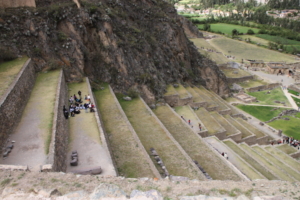
One of numerous Inca ruins in the Sacred Valley of the Incas. These giant terraces, known collectively as the Fortress or Temple Hill, sit below the Inca Temple of the Sun, in the town of Ollantaytambo. (2011 photo)
You like scenery? Peru geography includes parts of the Amazon River system, Andean mountains galore punctuated with gorgeous deep valleys and the altiplano (basically a very high plateau), plus a capital, Lima, that sits on a cliff overlooking the Pacific.
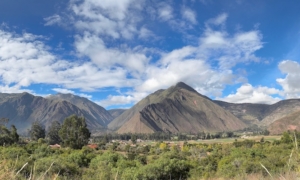
The Sacred Valley of the Incas. The valley floor where I took this photo is 9,776 feet above sea level.
You want an active vacation? Peru offers adventure sports such as trekking, horseback riding, mountain biking and rafting. Or, you can get out and about in search of the wildlife. For the truly Peru-specific thing, walk the Inca Trail (two-day or four-day version) to the Machu Picchu archaeological site. Except for those who walk, the only Machu Picchu access is via train to the village of Machu Picchu Pueblo, which sits below the ruins.
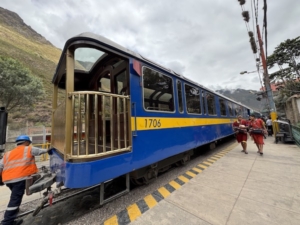
PeruRail cars readied for the journey from Ollantaytambo to Machu Picchu Pueblo, the village that sits below the famed Machu Picchu site.
You want to shop? Souvenir hunting, involving lots of brightly colored woven goods, is cost effective and rewarding at any popular tourist site and market town. Besides, there are multiple options to buy high-end goods, especially woven tapestries that could easily, and sometimes do, hang in art galleries.
You like food? The country, home to multiple species of several New World foods — Brazil nuts, chocolate, corn, potatoes, quinoa — is a foodie destination, most notably Lima. Specialties also include alpaca, guinea pig (cuy, locally) and the really delectable ceviche. UNESCO in 2023 placed Peruvian ceviche on its list of intangible cultural heritages of humanity.
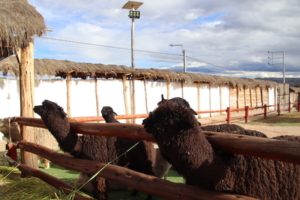
Alpacas, a source of wool and food.
Inkaterra
So naturally, my trip was too short. In Peru, trips always are. For this outing, I joined a press trip hosted by Peru’s Inkaterra hotels. A pioneer in sustainable tourism, Inkaterra is the winner of several sustainability prizes; it was recognized by the UN in 2021 as the world’s first climate positive hotel brand.
Chicha making is one of several cultural activities that, along with other more active options, is included in room rates at the Inkaterra properties. The Inkaterra properties offer their adventure/nature/eco-focused experiences to customers at any of five (soon to be six) mostly five-star hotels, located in forested and mountainous landscapes and at altitudes ranging from 600 feet above sea level in the Amazon River basin to 11,152 feet in Cusco. Our group stayed at three Inkaterra hotels, and also lunched at the super high-end La Casona, a protected 16th century manor house in Cusco.
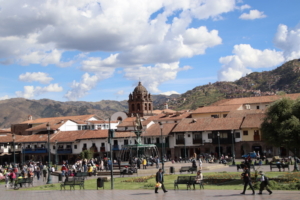
The central square at the heart of historic Cusco, a city rich in colonial heritage.
Our group hiked or floated on oxbow lakes and the Madre de Dios River to see or look for flora (the walking tree was the best) and fauna, such as tiny long-nosed bats, caimans, red howlers and even butterflies camping on turtles’ heads.
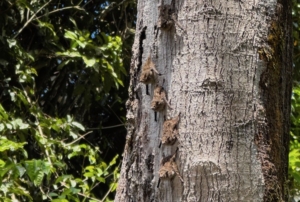
Above, tiny long-nosed bats positioned head down on a tree trunk. Below, butterflies drink the tears of turtles, for the sodium. Both were seen on the oxbow lake on the grounds of Hacienda Concepcion, which abuts the Madre de Dios River in the Amazon basin.
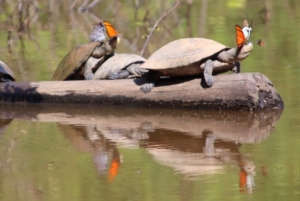
Beer, nuts, tea, stargazing, chocolate
However, we didn’t do any serious trekking, mountain biking, or the like, so I am emphasizing the cultural side of things below. Further to the cultural theme, sessions included:
• Making beer, as mentioned, while a guest at Hacienda Urubamba in the Sacred Valley of the Incas. As our guide showed us how to grind the corn, he advised that the entire process takes a couple of weeks. The ingredient list is short: yellow corn, flour, herbs, water — and a bit of chicha to kick-start fermentation. Chicha traditions, which predate European contact, call for saving some of each newly made brew for rituals and sharing the rest with the neighbors the minute it’s ready, usually with salsa on the side.
• Harvesting the arguably misnamed Brazil nuts, at Hacienda Concepcion in the rainforest outside Puerto Maldonado. Most often found in Bolivia and Peru as well as in Brazil, these trees cannot be domesticated so the nuts are harvested in the wild. Peru’s trees, protected on government land, drop shells — about 300 annually from a mature tree — each containing up to 22 seeds that must be hulled. Licensed harvesters use machetes to open the hard shells. Then, it is mostly women (“they’re more patient,” our guide said) who remove the husks from the seeds, using a vise. We tried our hands at removing husks without smashing the nuts. It does take patience.
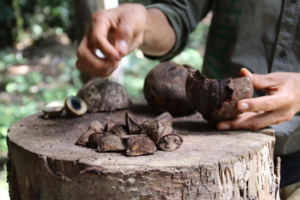
An opened Brazil nut shell and its 10-plus nuts. In the next step, nuts are shelled in a vise.
• Making tea, at Machu Picchu Pueblo Hotel. This Inkaterra property sits on 12.3 acres, which accommodate a tiny tea plantation — as well as 372 native orchid species, BTW. As to tea, the plants, originally from Japan, are 75 years old. Hotel staffers harvest and make tea, black and green, year round. For our part, we “harvested” a tiny number of leaves, rolled tea leaves and, skipping steps, made and filled teabags for use later the same evening. Machu Picchu Pueblo, which gives this hotel its name, is a small (6,000 people) village that was founded after discovery of the Machu Picchu archaeological site.
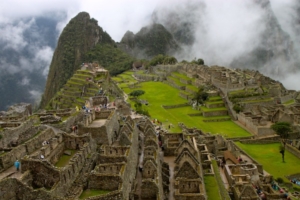
Above, sweeping view of the Machu Picchu archaeological site. Below, llamas hanging out on the terraces at Machu Picchu. (2011 photos)
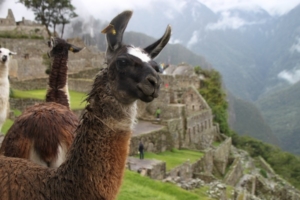
• Twilight stargazing, at Hacienda Urubamba, to gain insights into how Andean groups have relied on the stars for things like marking the seasons. Our outing involved a short tutorial on constellations seen in the Southern Hemisphere.
• Chocolate making, at Hacienda Concepcion. Although not on our itinerary, we watched a guest grinding cacao nuts as part of a chocolate making endeavor. This is worth mentioning because 60% of the world’s cacao species are indigenous to Peru. In fact, given Peru and its neighbors were key to bringing chocolate to the world, I am wondering why I didn’t eat more of it while so close to the source.
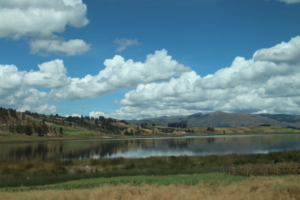
Above and below, more scenery, seen in this case while traveling the high-altitude roads outside of Cusco. The photo above was taken through a van window.
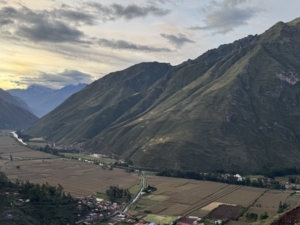
I meant to discuss shopping here, too, but this blog grew too fast. I discuss the shopping separately here: https://besttripchoices.com/peru-textiles-as-language/
For more information about Peru, we offer at BestTripChoices.com the following, under the headline, Land of Machu Picchu at https://besttripchoices.com/peru/
This blog and its photos are by Nadine Godwin, BestTripChoices.com editorial director and contributor to the trade newspaper, Travel Weekly. She also is the author of “Travia: The Ultimate Book of Travel Trivia.”
